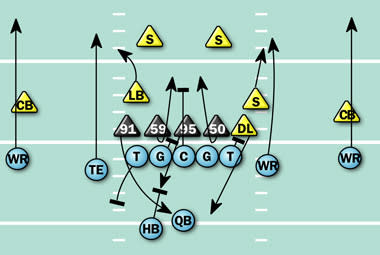Chiefs' blitz must get into a 'zone'
Also in this article:
Next Surveillance:
Bears
More NFL:
Editor's note: Yahoo! Sports will examine the biggest weakness of the 2009 season for every team and explain how the franchise can address the issue. The series continues with the Chiefs, who finished fourth in the AFC West (4-12).
Biggest problem in 2009: A defense vulnerable to everything

Chiefs linebacker Tamba Hali(notes) had eight and a half sacks last season.
(Photo by Ezra Shaw/Getty Images)
The Kansas City Chiefs have spent a great deal, both in actual dollars and draft currency, in their defensive front in recent years. From the first to third rounds between 2006 and 2009, Kansas City has drafted six defensive linemen and switched from a four-man line to a base 3-4 defense. Positional confusion has been the order of the day ever since – only end Tamba Hali has made a real impact. In 2009, the Chiefs put up a mere 22 sacks, second-worst in the NFL, and Hali had 8.5 of those. The Chiefs also gave up 7.6 yards per pass, and they were also an absolute sieve against the run, allowing 4.7 yards per carry. Glenn Dorsey(notes), the fifth overall pick in the 2008 draft, has become the poster child for the team's defense – the Chiefs don't seem to know where he's best utilized, and they're talking about putting the 6-foot-1, 300 former 4-3 collegiate defensive tackle to the 3-4 nose.
Another problem the Chiefs have is their inability to blitz consistently. According to Football Outsiders' game-charting numbers, only the Chargers and Colts rushed six or more defenders fewer times than Kansas City did. And that's a shame, because no team in the NFL last season was more effective when performing one specific kind of blitz package.
The 2010 solution: Get creative with the blitz
The zone blitz, invented by current Steelers defensive coordinator Dick LeBeau when he was with the Bengals in the mid-1980s, creates offensive confusion by dropping players into coverage from the line that you expect to be blitzing, and taking coverage men and putting them in blitz situations. In Pittsburgh, LeBeau has become especially creative with it – you may see safety Troy Polamalu(notes) crashing through the vacated A-gap while nose tackle Casey Hampton(notes) covers a flat where a running back might catch a quick screen. The idea is to disguise defensive intent, forcing the quarterback to make bad reads and incorrect decisions.
Per the aforementioned charting numbers, the 2009 Chiefs employed a zone blitz on 28 of a possible 1,045 defensive plays. Based on FO's defensive deficiency metrics, they should do it a lot more in 2010. Overall, Kansas City ranked 26th in FO's defensive DVOA (Defense-adjusted Value Over Average) – 31st against the run and 19th against the pass. But they were by far the most efficient defense in the NFL when they brought zone blitzes against their opponents. Of the 28 pass attempts against the Chiefs' zone blitzes, 11 were completed for just 97 yards and one touchdown. Of the 17 unsuccessful passes, two were interceptions and four were sacks. Think about that: Of the team's 22 sacks, four (18 percent) came on a series of formations the defense ran a mere 2.7 percent of the time.
Eli Manning(notes) of the Giants was the only quarterback to throw a touchdown pass against the K.C. zone blitz, but he also felt the heat. Early in the game, the Chiefs forced a Manning fumble with just the kind of aforementioned formation trickery.

On third-and-5 with 7:40 remaining in the first quarter, Manning took a shotgun snap and all of Kansas City's linebackers dropped into coverage. Only the base three linemen – the only ones with their hands on the ground – rushed Manning. Linebackers Jovan Belcher(notes) (59) and Mike Vrabel(notes) (50) gave quick blitz looks up the middle before rolling back into coverage. When left guard Rich Seubert(notes) and halfback Brandon Jacobs(notes) double-teamed nose tackle Ron Edwards(notes) (95), that gave Hali (91) the clearance needed to blow past left tackle David Diehl(notes) and take Manning down with a strip sack. Dorsey then recovered the fumble.
Of course, the zone blitz isn't failsafe, especially with questionable personnel – Manning's quick screen to Hakeem Nicks(notes) in the fourth quarter was a good read against a call in which more defenders drop than hold the point or give underneath zone looks. Nicks was able to run around most of the Chiefs' tackling-impaired defense for a touchdown as the Giants adjusted to the coverage drops with excellent downfield blocking. Still, the numbers really don't lie in this case. If the Chiefs want to get off the mat and start contending, they must find more ways to attack opposing offenses with different fronts and coverages.
